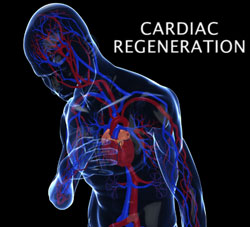« Prev Next »
Ah, the holidays...rich food, lounging around, and travel/family stress make me think of heart disease. A recent report in the Lancet has generated a lot of buzz on the potential use of a patient's own stem cells to repair a damaged heart following a heart attack. You may find the news report from many major outlets like this one, or you can google for more. 
Generally, the heart is severely damaged after an attack, and scar tissues immediately form around dead tissue to keep the heart from ripping itself apart while it still pumps. However, this scar tissue also weakens the patient over time by preventing efficient pumping and blood flow. Those in the regenerative medicine field are concerning with two major issues: 1) how to keep scarring at a minimum and 2) how to make new heart muscle cells to replace the dead ones and reverse progressive deterioration.
Roberto Bolli et al.1 reported the first phase of the SCIPIO trial in Lancet and showed data that injecting the patient's own adult stem cells into the heart after a heart attack improved heart function and reduced scarring. While the benefits are obviously exciting, I want to talk about all the "if's", "but's", and "maybe's" that received only dismissive hand-waving from reporters. I'm not trying to rain on anyone's parade. I want to point out how far we have come. It will likely require another decade or two to fully realize its full potential, and I hate seeing good studies brought down by hype. Those working in the field often recommend cautious optimism, and for good reason. They have seen enough failed studies to imagine how new-fangled treatments may not work. However, it seems nobody tries to lift the veil of undue optimism for the general public, which leads people to think that the next cure-all is only a few years away. So, I'll use this story to point out how hard it is for a study to even be credible.
This story is essentially a progress report of the SCIPIO trial, and represents the drawn-out, stepwise process that's typical of clinical research. It's a Phase I study showing the isolation and purification of heart stem cells from an undamaged piece of the patient's heart. The cells were grown and expanded outside the patient's body, and then re-injected back into the heart. The whole idea is basically to enrich the patient's own repair cells and apply them directly to the local damaged area to speed up repair after a heart attack.
Believe it or not, this type of experiment has been done many times in mice and rats2,3. They also showed improved heart function and reduced scarring. The debate now is how these adult stem cell injections work. Are they like seeds that simply grow into heart cells in the right environment? Do they form a hybrid with local cells? Or are they just secreting chemical signals that indirectly support local repair cells? If they are like seeds, have researchers found the right ones to inject and how much to inject? If they are supporting players, what signals are they sending and can we manipulate these signals artificially? More importantly, how can we identify the local repair cells?
These are important questions left over from at least one previous study, in which researchers injected bone marrow cells into patients after a heart attack4. Similar studies also showed significant patient improvement, but the benefits were all short-lived (about a year). It was later found that the bone marrow cells were secreting growth signals to support local cells, and when the marrow cells died the patients' condition worsen5. This is the major reason that researchers are more cautious this time around and adopting a wait-and-see attitude. There aren't enough data to show if these heart stem cell injections will be better or worse than the bone marrow cell injections. Nevertheless, that experiment needed doing and here we are.
To look on the bright side, I thought the researchers shown uncommon scientific rigor that was missing from earlier studies. The authors also took a very measured and transparent tone in their report. They were quick to point out that this is a very small study that included less than twenty patients, and took steps to explain the purpose of this study is to determine feasibility and safety, which are the purpose of all phase I trials. They did a great job characterizing the cells they injected (previous studies was rather slack in this area), and showed they have a standardized protocol for stem cell enrichment (other protocols were not so strictly standardized, and basically ran on a hope and a prayer). The authors admitted they didn't answer the big science questions (direct vs. indirect effect) and didn't try to dismiss it by saying something like "Well, it works. So, who cares how it works." They also gave a thoughtful discussion on all the questions debated in this field (see 5th paragraph). If nothing else, this study has built a superior platform to build future studies upon.
I must admit that I get a wistful feeling when I read papers like this, simply because I've read too many flawed studies. For the first time in a long time, I'm hopeful again and I can see serious progress embodied in this paper. Just a year ago, I would have thought isolating adult stem cells for transplantation was voodoo. This was mainly because of shoddy studies being presented as major breakthroughs. This time, people have learned from all those mistakes, found the controls they needed to do, and designed a feasible protocol that yielded credible results. My heart skips a beat just thinking about it.
Image credit: Duke University (http://research.duke.edu/stories/rethinking-stem-cells)
References:
- Bolli, R et al. Cardiac stem cells in patients with ischaemic cardiomyopathy (SCIPIO): initial results of a randomised phase 1 trial. Lancet 378(9806), 1847-57 (2011).
- Beltrami, AP et al. Adult cardiac stem cells are multipotent and support myocardial regeneration. Cell 114, 763-76 (2003).
- Tang, XL et al. Intracoronary administration of cardiac progenitor cells alleviates left ventricular dysfunction in rats with a 30-day-old infarction. Circulation 121, 293-305 (2010).
- Abdel-Latif, A et al. Adult bone marrow-derived cells for cardiac repair: a systematic review and meta-analysis. Arch intern Med 167, 989-97 (2007).
- Burdo, TJ et al. Bone Marrow Stem Cell Derived Paracrine Factors for Regenerative Medicine: Current Perspectives and Therapeutic Potential. Bone Marrow Res, 207326 (2011).






















